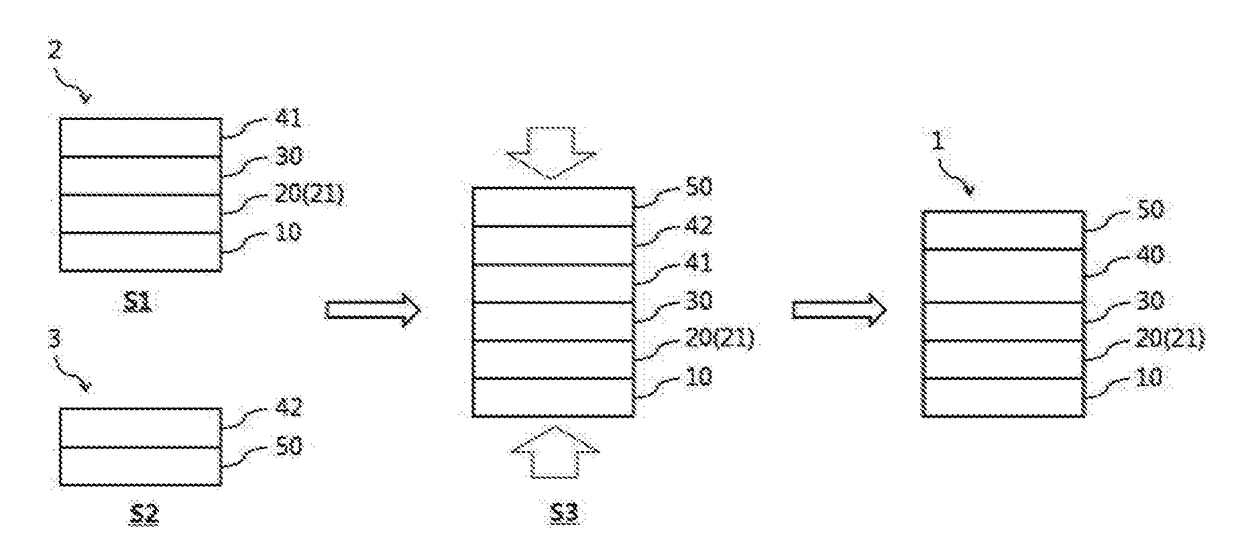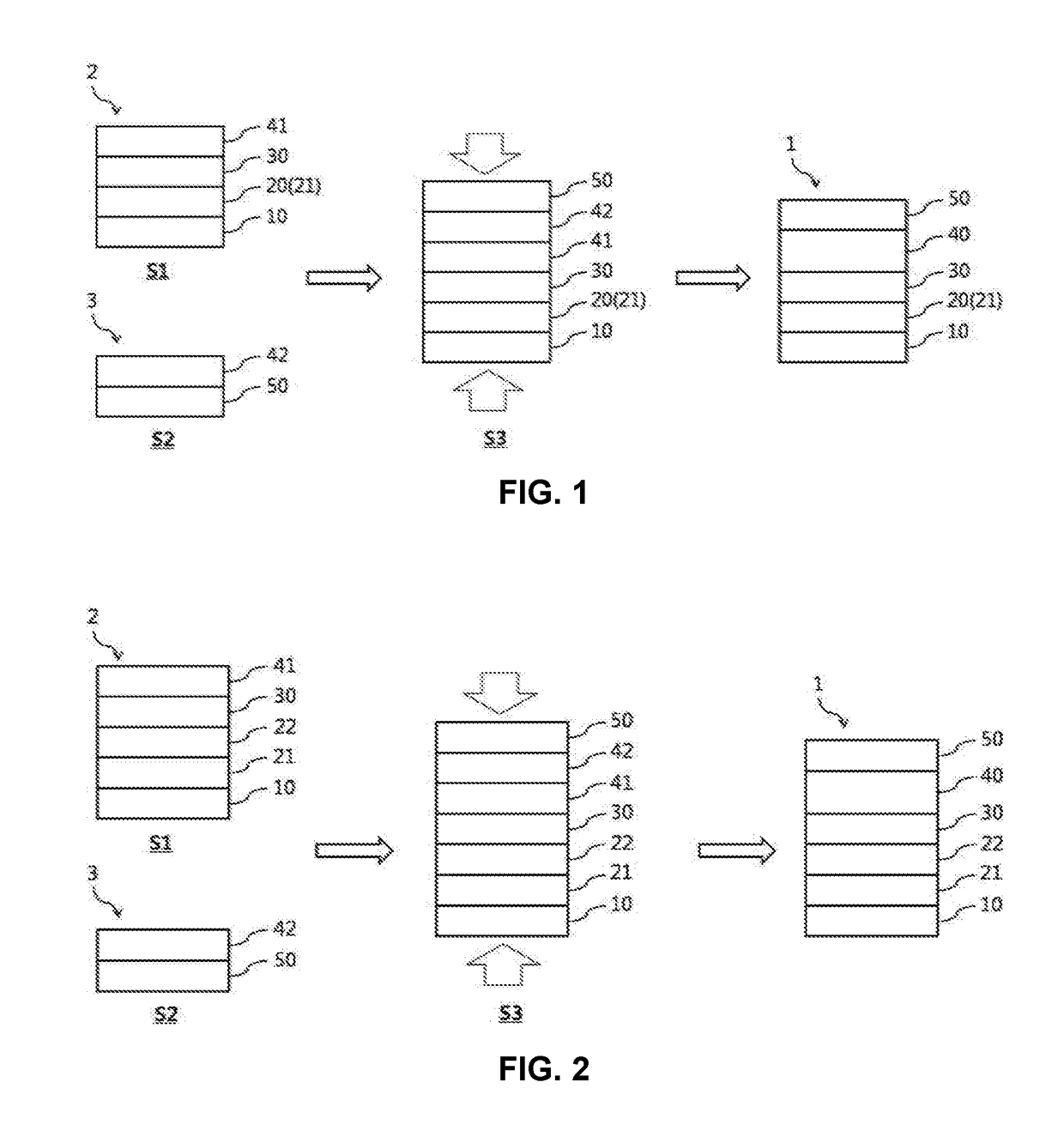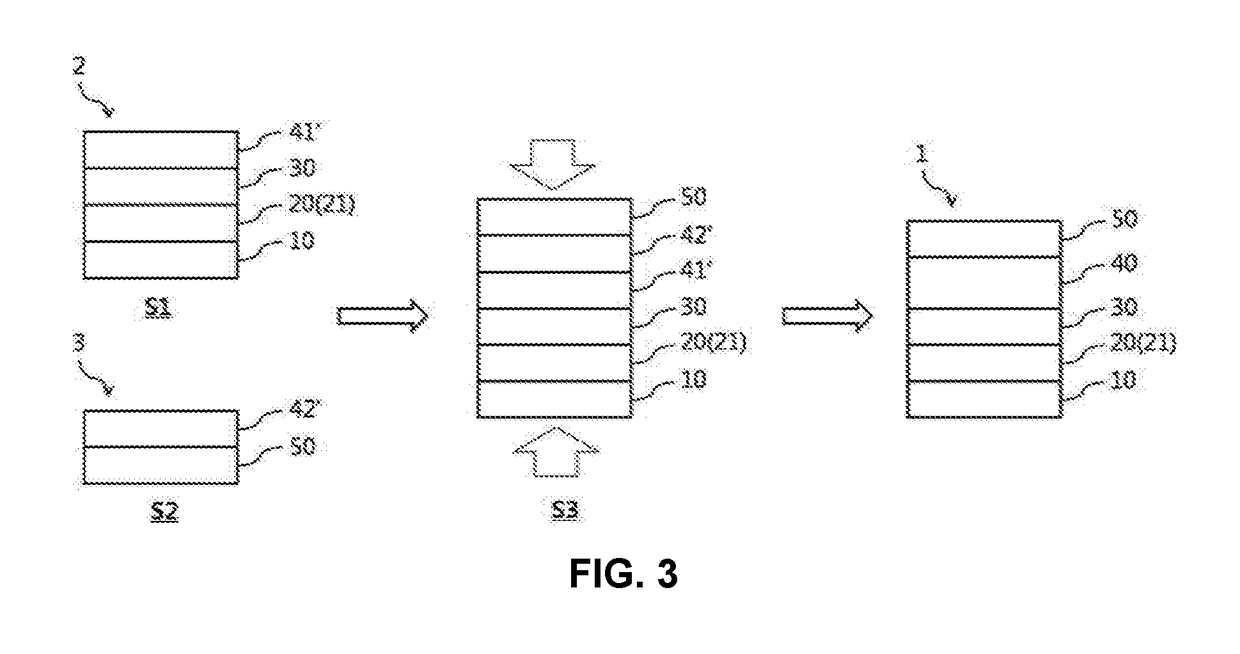Method for preparing a bonded type perovskite solar cell
- Summary
- Abstract
- Description
- Claims
- Application Information
AI Technical Summary
Benefits of technology
Problems solved by technology
Method used
Image
Examples
example 1
(1) Forming of First Substrate
[0099]1) Preparing transparent electrode: Fluorine tin oxide (FTO, TEC8) doped with fluorine was cut with 2.5 cm×2.5 cm and the FTO was partially removed by etching an end part.
[0100]2) Forming electron transport layer (blocking electron transport layer): A titanium acetylacetonateethanol (a volume ratio of 1 / 9) solution was sprayed on a transparent electrode heated at 450° C. several times to form a titanium dioxide thin film with a thickness of about 50 nm.
[0101]3) Forming light absorbing layer: 10 volume % of a HI aqueous solution was put in 40 wt % of a CH3NH3PbI3 (perovskite) / dimethyl formamide solution and then the solution was dropped on the electron transport layer and spin-coated at about 3,000 RPM for 200 seconds to form a light absorbing layer.
[0102]4) Forming first hole transport layer. A solution including poly-3-hexythiophene (P3HT) as a hole conductor, dichlorobenzene as a first solvent, Li-bis(trifluoromethanesulfonyl)imide (Li-TFSI) as ...
example 2
[0106]Except for forming the porous electron transport layer below after forming the blocking electron transport layer in the first substrate forming act in Example 1, the bonded type perovskite solar cell was prepared by the same method as Example 1.
[0107]Forming porous electron transport layer: A titanium dioxide paste (diSol: 18NR-T) diluted at a level of 20 nm was spin-coated on the blocking electron transport layer to form a porous electron transport layer with a thickness of about 200 nm. Thereafter, strength of the porous electron transport layer was enhanced by heating at 500° C. for 1 hr. Further, the first substrate (the porous electron transport layer / the blocking electron transport layer / the transparent electrode) was deposited in 20 mM of a tetrachloro-titanium dioxide aqueous solution at 60° C. for about 1 hr, washed with deionized water and ethanol and dried, and heated again at 500° C. for 30 minutes.
example 3
[0108]Unlike Example 1, a bonded type perovskite solar cell was prepared by using the second hole transport layer as a bonding medium of the first substrate and the second substrate. A difference from Example 1 was as follows and otherwise, the bonded type perovskite solar cell was prepared by the same method as Example 1.
[0109]Forming first hole transport layer: A solution including poly-3-hexylthiophene (P3HT) as a hole conductor, toluene as a first solvent, Li-bis(trifluoromethanesulfonyl)imide (Li-TFSI) as a lithium salt, and t-butylpyridine as an additive was dropped on the light absorbing layer and spin-coated at about 3,000 RPM for 60 seconds to form a first hole transport layer.
[0110]Forming second hole transport layer A solution including poly-3-hexylthiophene (P3HT) as a hole conductor, dichlorobenzene as a second solvent, Li-bis(trifluoromethanesulfonyl)imide (Li-TFSI) as a lithium salt, and t-butylpyridine as an additive was dropped on the opposing electrode and spin-coa...
PUM
| Property | Measurement | Unit |
|---|---|---|
| Temperature | aaaaa | aaaaa |
| Temperature | aaaaa | aaaaa |
| Time | aaaaa | aaaaa |
Abstract
Description
Claims
Application Information
 Login to View More
Login to View More - R&D
- Intellectual Property
- Life Sciences
- Materials
- Tech Scout
- Unparalleled Data Quality
- Higher Quality Content
- 60% Fewer Hallucinations
Browse by: Latest US Patents, China's latest patents, Technical Efficacy Thesaurus, Application Domain, Technology Topic, Popular Technical Reports.
© 2025 PatSnap. All rights reserved.Legal|Privacy policy|Modern Slavery Act Transparency Statement|Sitemap|About US| Contact US: help@patsnap.com



